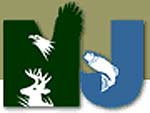

Trenton, NJ –-(Ammoland.com)- Although bobcats are considered a game species, they are currently classified as “Endangered” in New Jersey and are therefore managed by the Division of Fish and Wildlife’s Endangered and Nongame Species Program.
There is no open hunting or trapping season for bobcat, and it is illegal to intentionally take, kill or attempt to take or kill one in the State.
Bobcats legally harvested in other U.S. states or Canadian provinces may be possessed provided the pelt is affixed with a CITES tag from the state or province of harvest.
Bobcats thrive in a variety of habitats with high prey abundance and dense understory vegetation, including hardwood forests, mixed forests, brush, swamps and farmland habitats). Forest edges and rocky ledges and outcrops are also important terrain features. Bobcats seem to use the convenience of woods roads and established paths in forests to aid travel.
Bobcats are widely distributed across New Jersey, but are mainly found in the northwestern counties of Sussex, Warren, Passaic and Morris. They are scarce in the central and southern counties of the state. Trappers should make every reasonable effort to avoid taking bobcats, and should know what to do if a bobcat is accidentally captured.
Back feet often follow in the front foot tracks of bobcats. Bobcat track trails tend to “wander” compared with the more straight-line patterns of wild canids (foxes and coyotes). Bobcats travel and hunt with a deliberate and methodical walking pattern, rarely bounding unless chasing prey. Bobcat tracks are approximately 1½ – 2½ inches long and 1 3/8 – 2½ inches wide in dirt and up to 2½ inches long and 2¾ inches wide in snow. Bobcats have 4 toe pads on the front and hind feet. Claw marks typically do not show in tracks as they do with canids.
Coyote/Bobcat Track Comparison
Information to Help Avoid Bobcat Captures
- Wherever a bobcat track is identified, cable restraint sets should not be made in close proximity.
- Every year a growing number New Jersey trappers discover to their extreme discomfort that a bobcat is in one of their restraints, and that making sets on or near existing bobcat sign is a real problem as bobcats will repeatedly use the same travel patterns within their territories.
- Bobcats tend to use areas where cottontail rabbits are abundant. Trail sets that are effective for wild canids (fox and coyote) can be expected to capture bobcats as cats will follow canine trails, particularly those in open fields.
- Lures and baits that appeal to one species appeal to others as well. Visible baits of any kind, especially rabbits or parts of rabbits, should not be used if any bobcats frequent the area. Sight-attractants such as bird wings, feathers, pieces of fur, should not be used near the traps if bobcat may be present.
- The use of tainted rather than fresh meat baits provides significant attraction to coyotes and foxes but tends not to attract bobcat.
Reducing Mortality and Injuries to Incidentally Captured Bobcats
If you find a bobcat (alive or dead) in one of your sets, call: 877-WARN-DEP (877-927-6337). The dispatcher will notify the appropriate Endangered and Nongame Species zoologist. The dispatcher will record the trapper’s name and phone number. The zoologist will then immediately contact the trapper to meet with him/her and release/remove the bobcat from the cable restraint.
It is very important that a live bobcat be released as soon as possible to prevent further injury or death to the animal that might result from a prolonged time spent in the trap device. Every trapper should have and carry a catchpole and wire cutters as part of their basic trapline equipment to allow safe release of any unintended animal captures. Trappers are also advised to have a piece of heavy canvas (or carpet) large enough to cover a bobcat and a pair of heavy duty leather gloves.
How to Release a Snared Bobcat
- Approach any trapped bobcat slowly to avoid causing them to move about excessively. Never attempt to render a bobcat unconscious with a blow to the nose or head or by any other means. Life threatening injury to the bobcat may result.
- A bobcat will allow the catchpole loop to be placed over its head, but it can be expected to react when the loop is tightened. Tighten the catchpole loop only sufficiently to hold the bobcat securely without preventing its ability to breathe. If a catchpole is not available, an alternative method to release bobcat is to cut a strong forked stick to allow the pinning of the bobcat’s neck and shoulder to the ground while the snare is removed.
- It is important to keep the head of the bobcat pinned down to the ground. Quickly place a foot, with light pressure only, on the hindquarters to restrain the rear legs. Always be aware a bobcat may try to lash out at you with claws extended on any paw.
- Once the bobcat is immobilized, the canvas/carpet can be placed over the prone animal to quiet it as the cable restraint is cut off or removed quickly.
- The catchpole loop should only then be relaxed and removed to allow the animal freedom to escape. Important! – Special care should always be taken when releasing a bobcat. They are very capable of injuring the trapper with their teeth or claws.
The post How to Avoid the Capture of Bobcats while Trapping Other Furbearers appeared first on AmmoLand.com.
